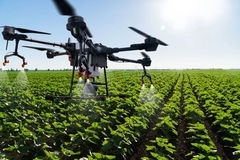EFSA Finds No Health Risk in Dow GM Cotton Product
In delivering its scientific opinion, the EFSA GMO Panel considered the application EFSA-GMO-NL-2005-16, additional information supplied by the applicant, scientific comments submitted by Member States, and relevant scientific publications.

16 Jun 2010 --- Following the submission of an application (EFSA-GMO-NL-2005-16) under Regulation (EC) No 1829/2003 from Dow AgroSciences, The EFSA Scientific Panel on Genetically Modified Organisms (EFSA GMO Panel) was asked to deliver a scientific opinion on the safety of the insect resistant genetically modified (GM) cotton 281-24-236 x 3006-210-23 (Unique identifier DAS-24236-5 x DAS-21Ø23-5) for food and feed uses, import and processing.
In delivering its scientific opinion, the EFSA GMO Panel considered the application EFSA-GMO-NL-2005-16, additional information supplied by the applicant, scientific comments submitted by Member States, and relevant scientific publications. The scope of application EFSA-GMO-NL-2005-16, includes the cotton 281-24-236 x 3006-210-23 and its derived-products, to be used for animal feed (e.g. cake of cottonseed, hulls), for human food products (e.g. oil, linters) and for industrial uses (e.g. textile fibre), but excluding cultivation in the EU. The EFSA GMO Panel assessed cotton 281-24-236 x 3006-210-23 with reference to the intended uses and principles described in the Guidance Documents of the Scientific Panel on Genetically Modified Organisms for the risk assessment of genetically modified plants and derived food and feed (EFSA, 2006a) and for the risk assessment of genetically modified plants containing stacked transformation events (EFSA, 2007). The evaluation of the risk assessment included molecular characterisation of the inserted DNA and data for the newly expressed proteins. An evaluation of the comparative analysis of composition, agronomic and phenotypic traits was undertaken, and the safety of the newly expressed proteins and the whole food/feed were evaluated with respect to potential toxicity, allergenicity and nutritional quality. An evaluation of environmental impacts and of the post-market environmental monitoring plan was undertaken.
Cotton 281-24-236 x 3006-210-23 has been produced by conventional crossing between lines of the single events 281-24-236 and 3006-210-23, and subsequently self-pollinated for five generations to obtain the GM cotton 281-24-236 x 3006-210-23 homozygous for both inserts to achieve insect resistance traits against certain lepidopteran pests, such as Heliothis zea (cotton bollworm), Heliothis virescens (tobacco budworm) and Pectinophora gossypiella (pink bollworm), by the expression of Cry1F and Cry1Ac proteins. PAT protein was used as a selectable marker during transformation processes. The EFSA GMO Panel evaluated the risk assessment on the stacked cotton 281-24-236 x 3006-210-23, as well as its respective single events.
The molecular characterisation data established that event 281-24-236 contained a single insertion with the cry1F and pat genes and an additional pat fragment. The event 3006-210-23 contained a single insertion with the cry1Ac and pat genes. Analyses of the integration sites including sequence determination of the inserted DNA and flanking regions and bioinformatic analyses have been performed. Bioinformatic analyses of the flanking regions indicated that the 281-23-236 insertion occurred into the 3’ untranslated region of a gibberellin 20-oxidase gene. Updated bioinformatic analyses of event 3006-210-23 did not indicate the interruption of any known endogenous coding or regulatory sequences. Bioinformatic analyses of junction regions demonstrated the absence of any new open reading frames (ORFs) potentially coding for known toxins or allergens. The expression of the genes introduced by genetic modification has been sufficiently analysed and the stability of the genetic modification has been demonstrated over several generations for both 281-24-236 and 3006-210-23 events. Moreover, the insert structure of both single events was retained in the stack 281-24-236 x 3006-210-23. The EFSA GMO Panel is of the opinion that the molecular characterisation of the DNA inserts and flanking regions of cotton 281-24-236 x 3006-210-23 does not raise any safety concern, and that sufficient evidence for the stability of the genetic modification was provided.
The comparative compositional analysis of cottonseed and derived products, as well as the analysis of agronomic and phenotypic characteristics, of the GM cotton 281-24-236 x 3006-210-23 and its respective single events in field trials at locations representative of commercial cotton cultivation in the USA, showed that cotton 281-24-236 x 3006-210-23 and both single events are compositionally, agronomically and phenotypically equivalent to their conventional counterpart. This also indicates that the above mentioned 281-24-236 insertion into the 3’ untranslated region of a gibberellin 20-oxidase gene did not alter the compositional and agronomic characteristics. Based on the assessment of data available, including the additional information provided by the applicant in response to the EFSA GMO Panel’s requests for the GM cotton 281-24-236 x 3006-210-23, for the single events and for its conventional counterpart, the EFSA GMO Panel has found no indication that crossing of cotton 281-24-236 and 3006-210-23 results in interactions between the single events which causes compositional, agronomic or phenotypic changes. No indications of possible adverse effects of the newly expressed Cry1Ac, and Cry1F and PAT proteins were found in studies on potential toxicity and allergenicity, including bioinformatic studies and investigations on stability, digestibility and animal toxicity. Based on the mode of action of the Cry and PAT proteins and given all information provided, the EFSA GMO Panel concludes that interactions between the single cotton events that might impact on food and feed safety are unlikely, and data from a feeding study with broiler chickens showed that the nutritional properties are similar to those of its conventional counterpart, further confirming the outcomes of the compositional analysis.
There is therefore no requirement for scientific information on possible environmental effects associated with the cultivation of cotton 281-24-236 x 3006-210-23 as the environmental risk assessment is restricted to the indirect exposure through manure and faeces mainly from animals fed with cotton products of 281-24-236 x 3006-210-23 and with the accidental release into the environment of cotton 281-24-236 x 3006-210-23 grains during transportation and processing. There are no indications of increased likelihood of establishment or survival of feral cotton plants. If accidental spillage and subsequent release into the environment of 281-24-236 x 3006-210-23 cottonseed occur, cotton 281-24-236 x 3006-210-23 plants would have a selective advantage only under infestation of target pest species or in the presence of glufosinate-ammonium herbicides, which are not commonly used on cultivated cotton or in most areas where the GM cotton might be spilled. The EFSA GMO Panel therefore concludes that unintended environmental effects due to the establishment and spread of cotton 281-24-236 x 3006-210-23 will not be different from that of conventional cotton.
Considering the intended uses of cotton 281-24-236 x 3006-210-23, the monitoring plan provided by the applicant is in line with both the EFSA GMO Panel Guidance Document for the risk assessment of genetically modified plants and derived food and feed and the opinion of the EFSA GMO Panel on post-market environmental monitoring. However, the EFSA GMO Panel is aware that, due to physical characteristics of cottonseed and methods of transportation, accidental spillage cannot be excluded. Therefore the EFSA GMO Panel recommends that, within general surveillance, appropriate management systems are introduced to actively monitor the occurrence of feral cotton plants in areas where cottonseed spillage and plant establishment are likely to occur. The EFSA GMO Panel also recommends that appropriate management systems should be in place to restrict seeds of cotton 281-24-236 x 3006-210-23 entering cultivation as the latter requires specific approval under Directive 2001/18/EC or Regulation (EC) No 1829/2003.
In conclusion, the EFSA GMO Panel considers that the information available for cotton 281-24-236 x 3006-210-23 addresses the scientific comments raised by Member States; and that the cotton 281-24-236 x 3006-210-23 as described in this application is as safe as its conventional counterpart and other appropriate comparators with respect to potential effects on human and animal health and the environment. The EFSA GMO Panel thus concludes that cotton 281-24-236 x 3006-210-23 is unlikely to have any adverse effect on human and animal health and the environment in the context of its intended uses.












